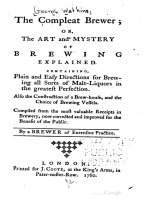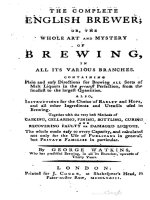- Trang chủ >>
- Khoa Học Tự Nhiên >>
- Vật lý
beer tap into the art and science of brewing mar 2003
Bạn đang xem bản rút gọn của tài liệu. Xem và tải ngay bản đầy đủ của tài liệu tại đây (5.4 MB, 247 trang )
Beer:
Tap into the Art and
Science of Brewing,
Second Edition
CHARLES BAMFORTH
OXFORD UNIVERSITY PRESSCHARLES BAMFORTH
BEER
Tap Into the Art
and Science
of Brewing
SECON D EDITION
2003
1
3
Oxford New York
Auckland Bangkok Buenos Aires Cape Town Chennai
Dar es Salaam Delhi Hong Kong Istanbul Karachi Kolkata
Kuala Lumpur Madrid Melbourne Mexico City Mumbai Nairobi
São Paulo Shanghai Taipei Tokyo Toronto
Copyright © 2003 by Oxford University Press, Inc.
Published by Oxford University Press, Inc.
198 Madison Avenue, New York, New York 10016
www.oup.com
Oxford is a registered trademark of Oxford University Press
All rights reserved. No part of this publication may be reproduced,
stored in a retrieval system, or transmitted, in any form or by any means,
electronic, mechanical, photocopying, recording, or otherwise,
without the prior permission of Oxford University Press.
Library of Congress Cataloging-in-Publication Data
Bamforth, Charles W., 1952–
Beer : tap into the art and science of brewing / by Charles Bamforth—2nd ed.
p. cm.
Includes bibliographical references and index.
ISBN 0-19-515479-7
1. Brewing—Amateurs’ manuals. 2. Beer. I. Title.
TP577 .B34 2002
641.8′73—dc21 2002066318
987654321
Printed in the United States of America
on acid free paper
For Diane, Peter, Caroline, and Emily
They who drink beer will think beer.
—Washington Irving
You can’t be a Real Country unless you have a beer and
an airline–it helps if you have some kind of a football team,
or some nuclear weapons, but at the very least you need a beer.
—Frank Zappa
In my opinion, most of the great men of the past were
only there for the beer.
—A. J. P. Taylor
God has a brown voice,
as soft and full as beer.
—Anne Sexton
I would like you to imagine for a moment that beer did not exist on our
planet in any shape or form. Is it possible, or even probable, that anyone
would invent this beverage as we know it today? And even if someone did
“invent” beer, would they be able to convince any rational-minded busi-
nessperson to invest in the concept?
The answer, of course, is no. The process of brewing beer is a complex,
somewhat convoluted, and, at times, mysterious endeavor that has evolved
from what was probably a prehistoric accident.
The truth is, the average beer drinker today probably has very little
understanding or appreciation of what goes into producing his favorite six-
pack. And no wonder! This simple beverage, that is consumed by millions
of people around the world every day and is taken for granted by most who
enjoy it, is produced by a process that many would regard as modern-day
alchemy.
Professor Bamforth (Charlie) wrote the first edition of Beer to unveil and
explain this process in a meaningful, accurate and digestible form. In this
newest edition, revised and updated, Charlie has added a new dimension to
his original excellent text by further giving the reader a glimpse of the inter-
play between the process and the people who make it happen.
Charlie’s creativity, sense of humor and wit, and unique perspective on
beer and brewing come through at an even higher level in this new edition.
Charlie is a world-recognized authority on beer and brewing, and there is
no doubt that this man loves beer.
Foreword
Doug Muhleman
Achieving the taste characteristics of a fine beer is truly a combination
of art and science. The quality of the beer is dependent not only on the qual-
ity of the ingredients and the process but also on the quality of the knowl-
edge, understanding, and experience that went into making it. In this book,
Charlie vary capably provides this very important foundation.
Whether you are a brewmaster, a marketer, an amateur brewer, or a beer
enthusiast, this book will enrich and expand your understanding and appre-
ciation of this noble beverage.
Foreword
x
Not long before leaving England to take up my role as professor of malting
and brewing sciences at the University of California, Davis, in February 1999,
I was the guest on a local radio show in Guildford. Two questions I remem-
ber well.
The first was: “Charlie, did you think as a young boy at school in Lanca-
shire that you would one day be the beer professor in California?” to which
the instinctive reply, of course, was: “Well, it’ll be a lousy job but I guess
somebody has to do it. Must be my debt to society.” I was, of course, using
irony, lest anybody think I meant it!
The second question was more irritating. “Charlie, how will you pos-
sibly be able to enjoy those weak and tasteless beers over there after so long
drinking our lovely English ales?” I was composed, replying thus:
It’s horses for courses. If I am in a 300-year-old thatched West Sussex
pub, my bald head scraping the ceiling, snow outside, a roaring log
fire within, a plate of shepherd’s pie to devour from atop a well-
scrubbed oaken table of great antiquity, then a pint of flat, generously
hopped ale is a delight. However, if I’m in a baseball stadium, seventh
inning stretching with a pile of nachos topped with jalapenos and
40 degrees of Mr. Celsius’s best frying my few follicles, then an ice
cold Bud is to die for. And, by the way, if you’re talking “weak,” then
do remember that a U.S. lager will typically contain 20% more alco-
hol (at least) than an ale from England.
Preface
On that occasion they didn’t ask me the usual question beamed at a
brewing professor: “But what is your favorite beer?” Usually I reply, “One
that’s wet and alcoholic,” which is, of course, something I don’t believe. Just
like there are good and bad footballers, and good and bad vicars, indeed
good and bad virtually anything, then there are certainly beers (rather too
many of them) that are plainly deplorable. Unquestionably, though, the great
Brewers of the world invariably delight the customer with their wares. A
great many gently flavored lagers are superb, and so wonderfully consistent.
They have to be, for they are unforgiving and will reveal any conceivable
shortcoming in raw material, process, or packaging. Equally, I can take you
to some intensely flavored ales that are completely out of balance and de-
void of all drinkability. There is no simple correlation between excellence
and depth and complexity of flavor.
Which is why I get hopelessly infuriated with self-styled beer gurus
who pontificate about what an ale or a lager should or should not be and
about what should and what should not be the raw materials and processes
that ought to be used, without the remotest understanding of the real sci-
ence and technology of the brewer’s art and the trials and tribulations of
everyday existence in a brewing company.
This book attempts to give a reasoned view on such issues from the per-
spective of a longtime brewing scientist, research manager, quality assurance
manager, customer, and, latterly, the bloke with the best job in the world.
Preface
xii
A year or two ago I was idly flicking between television channels when I
chanced upon a couple of people sipping beer and discussing their findings.
One of these people has established a reputation as being something of a
wine connoisseur and would appear to take particular pride in pinpointing
the exact vintage of the bottle and the winery in which it was produced. For
all I know, that person may be able to name and give the shoe size of the
peasant who trod the grapes. With rather more certainty, however, I was able
to conclude that this person’s knowledge of beer was mediocre, or worse.
From time to time, too, I come across articles in the general press, that
pontificate about beer in a manner not unlike that of this wine buff. I ap-
plaud the efforts of some of these authors to help maintain beer in the col-
lective consciousness. I deplore it, however, when they attempt to preach on
the rights and wrongs of brewing practice. It is galling when they dress up
the taste and aroma of beer in ridiculous terminology. Personally, I have
enormous difficulty reconciling the language they use with the tastes of the
myriad of beers that I have had the great good fortune to consume across
the world.
An analogous situation exists in my own “other life.” While it is research
into the science of brewing and beer that pays my mortgage and puts food
in the mouths of my children, my hobby is to write articles about soccer. I
hope (and believe) that they help contribute to the pleasure of the fans who
read them, but I hope I would never be accused of trying to tell the profes-
sionals within the game of how to do their jobs. I might fairly articulate the
Preface
to the First
Edition
views of an “outsider”—the fan’s-eye view—but I trust that it’s the coaches
and the players within soccer who know their specialization and can deliver
a product that will thrill and delight me.
Rather more is written about beer in the nonspecialist press by “fans”
than by “professionals.” There is room for both—and that is why I decided
to write this book, in an attempt to partly redress the balance. In it, I have
attempted to capture the proud history of brewing, which stretches back to
a time when articles on the merits of beer will have been written on papyrus
or scrawled in hieroglyphics on walls of clay. I have attempted to convey the
somewhat complex science of brewing in straightforward terms, with par-
ticular emphasis on why the properties of beer are as they are. I have en-
deavored to show what are the sensible and meaningful ways in which beer
quality can be described. And I have tried to entertain, without trivializing
a proud and distinguished profession.
I like beer, and, like the majority of people working in the brewing in-
dustry, I care about it and about the people who drink it. In this book I draw
attention to a myriad of recent studies that suggest that beer (and other al-
coholic drinks) are beneficial components of the adult diet, provided they
are consumed in moderation. I certainly have no intention of encouraging
the irresponsible to abuse the pleasure that comes from drinking beer in
moderation, at the right time, in the right place.
I want people to understand and appreciate their beer and to gain an
insight into the devoted labors of all those whose combined efforts bring it
to the glass: the farmer who grows the best barley; the hop grower cultivat-
ing a unique crop; the Maltster, who converts barley into delicious malt; the
Brewer who combines malt and hop to feed a yeast that they and their pred-
ecessors will have protected for perhaps hundreds of years; the bartender
who keeps the beer in top condition.
This book is about facts. Where there is scope for expressing opinions,
then these are my own, and not everyone in the brewing trade will neces-
sarily agree with them. They have, though, been arrived at in a career in the
brewing profession approaching 25 years. From reading this book I hope
you will form a considered opinion about brewing and about beer—and be-
come rather better acquainted with its art and science.
Preface to the First Edition
xiv
Through my scientific career I have been fortunate in having a number of
guiding lights, without whose interest it would have been impossible to con-
template this small book. It was my Ph.D supervisor, Peter Large, who
taught me the pleasures of research—and of good ales in the pub paradise
that is Hull. My post-doc with Rod Quayle, F.R.S., in Sheffield, was perhaps
the most delightful and productive stage of my career in England. In 1978 I
was brought into the industry by John Hudson, a redoubtable Yorkshireman
who placed enormous stock in the proper use of the English language. Di-
rector of the Brewing Research Foundation at the time was Charles Dalgliesh,
the first person in the industry to champion my work and to encourage one
to have the courage to stand up to dyed-in-the-wool dogma. I was taken into
the Bass fold by Tony Portno, a fellow Lancastrian and equally blunt spoken,
and then nurtured into the ways of the famed Red Triangle by Stuart Molzahn.
It was Tony who insisted I have my smooth academic edges roughened by a
stint at the “coal face,” and him I must thank for the invaluable experience
of being quality assurance manager at Bass’s most modern brewery. Another
Lancastrian and true visionary, Bernard Atkinson, took me back to the Brew-
ing Research Foundation and pointed me to an international awareness. At
this time, also, I was honored to be made visiting professor of brewing at
the International Center of Brewing and Distilling at Heriot-Watt University,
Edinburgh, Scotland, allowing me to work closely with my very big buddy
Graham Stewart.
Thence, early in 1999, to California, thanks to the generosity of Anheuser-
Acknowledgments
Busch in endowing the Chair of Malting and Brewing Sciences at the Uni-
versity of California, Davis. In particular I thank Doug Muhleman (Group
Vice President, Brewing Operations and Technology, Anheuser-Busch, Inc.),
champion of this endowment and inspiration. I thank him, too, for sparing
some of his formidable schedule to pen the foreword to this volume. At
Davis I grabbed the baton and great encouragement from Michael Lewis, a
gifted teacher and valued friend.
Countless coworkers, students, and friends have shared my adventure
in beer and brewing—and hopefully there will be plenty more to come.
Some things, though, always remain constant, above all the love and sup-
port of my wife, Diane, and our children, Peter, Caroline, and Emily. Once
more I dedicate my book to them.
I thank my publishers, notably Kirk Jensen, for their patience and inter-
est. Special thanks to Dr. Bill Vollmar, corporate historian of Anheuser-Busch,
Inc., for access to his vast resources, and to Steve Harrison and Noah Ceteras
of Sierra Nevada for much valuable material. Acknowledgment of the sup-
pliers of other illustrative material is made in the legends to the figures.
Acknowledgments
xvi
Foreword by Doug Muhleman ix
Introduction
3
1 From Babylon to Busch: The World of Beer and Breweries 7
2 Grain to Glass: The Basics of Malting and Brewing 49
3 Eyes, Nose, and Throat: The Quality of Beer 65
4 The Soul of Beer: Malt 87
5 The Wicked and Pernicious Weed: Hops 109
6 Cooking and Chilling: The Brewhouse 123
7 Goodisgoode: Yeast and Fermentation 141
8 Refining Matters: Downstream Processing 159
9 Measure for Measure: How Beer Is Analyzed 171
10 To the Future: Malting and Brewing in Years to Come 187
Appendix: Some Scientific Principles 197
Glossary 205
Notes 217
Further Reading 219
Index 221
Contents
one-time Unitarian minister, penned many learned thoughts. The reader will
forgive me if I select just 13 words from the great man: “God made yeast . . .
and loves fermentation just as dearly as he loves vegetation.”
Beer, surely, is a gift of God, one that brings together yeast and vegeta-
tion (in the shape of barley and hops) in a drink that has been enjoyed for
8,000 years, a beverage that has soothed fevered brows, nourished the hun-
gry, and coupled friendly and unfriendly alike—it’s even seen men off into
battle. “No soldier can fight unless he is properly fed on beef and beer,” said
John Churchill, the first duke of Marlborough (1650–1722), a great British
tactician and a forebear of the even more celebrated Winston.
Queen Victoria (1819–1901) was another who recognized the merit
of beer: “Give my people plenty of beer, good beer and cheap beer, and
you will have no revolution among them.” With these sentiments, the re-
doubtable monarch echoed the enthusiasm of the Athenian tragedian Eu-
ripides (484 – 406
BC):
The man that isn’t jolly after drinking
Is just a driveling idiot, to my thinking.
This book is not an exercise in trying to convince you, the reader, of the
merits and demerits of drinking beer. I assume that as you have picked it up,
and are starting to read, you have an existing interest in beer. The aim of this
Introduction
3
book is to give the nonspecialist a feel for the science and technology that
underpin a truly international beverage. I use the word “international,” ac-
cepting that to do justice to the entire world of beer would have demanded
more than a single volume. Markets differ considerably from country to coun-
try, but the scientific principles of brewing are constant the world over. It is
the science and the technology about which I particularly wish to inform the
reader, for the processes involved in the brewing of beer are as fascinating as
they are, in some ways, unique.
I have several audiences in mind for this book. First, and perhaps fore-
most, are the laypeople who want to know, in reader-friendly terms, what
goes into their beer. Such people seek to understand the magic that under-
pins this supreme alchemy, namely the conversion of barley and hops, by
yeast, into something so astonishingly drinkable. My desire is to reinforce
the pleasure people take in responsibly drinking beer by informing them
about the myriad of biochemical and chemical reactions that are involved in
the production of their favorite drink and by exposing them to the enor-
mous reservoir of science and technology that makes malting and brewing
two of the great “traditional” industries. It is my earnest hope that, by read-
ing this book, beer drinkers will come to appreciate the care that goes into
making every pint of beer. I will be describing a science, or rather, a range of
sciences, and so can’t avoid using scientific terms. Hopefully I have achieved
this in a way that is readily understandable for those without mastery of
chemistry, biology, physics, chemical engineering, and the other scientific
disciplines on which brewing is founded. I have provided a simple explana-
tion of the underpinning science as well as a comprehensive glossary at the
end of the book.
A second group of people who should benefit from reading this book
are those who are joining the brewing industry and who wish to have a
“friendly” introduction to humanity’s oldest biotechnology. Among these
readers will be those entering in nontechnical roles: sales, marketing, fi-
nance . . . chief executives!
Third, there are those who interact professionally with brewing, either as
suppliers or retailers, and who need to know why the Brewer is so demand-
ing in its requirements and is so very proud of its heritage (I use Brewer [or
Maltster] with a capital letter when referring to a brewing [or malting] com-
pany, but brewer and maltster in the lower case when describing an individ-
ual practitioner of the art).
A valued colleague has extremely strong views on the use of language in
books and lectures about the brewing business. I well recall having finished
giving a lecture in Canada that I thought had gone across very nicely, when
B E E R
4
she stormed up to me, asking darkly whether I had a view on whether
women as well as men drank beer. Puzzled, I replied, “Of course they do.”
“Then why,” she replied, acidly, “did every reference to the beer drinker in
your talk consist of ‘he this,’ ‘he that.’” I had meant no offense by it, using
“he” in the generic sense, but I haven’t made the mistake since. For this rea-
son, I intersperse the words “he” and “she” throughout this book. As we will
see in chapter 1, it was the female of the species who was once primarily re-
sponsible for brewing the ale; she was called the “brewster.”
Another problem I had to confront was the matter of units. Brewers in
different countries have their own scales of measurement. Even when the
same name is used for a unit, it doesn’t necessarily mean the same thing in
different countries. Thus, a barrel in the United States comprises 31 gallons,
whereas a barrel in the United Kingdom holds 36 gallons—and just to com-
plicate matters further, a U.S. gallon is smaller than a U.K. gallon. I have
used both types of “barrel” at various points and have indicated whether it’s
a U.S. or a U.K. variant. The international unit for volume, however, is the
liter or the hectoliter (hl; 100 liters). By and large, this and other metric
terms are employed because Brewers across the world do tend to use them,
as well as their own parochial preferences. A gallon equates to 3.7853 liters
in the United States; hence a U.S. barrel holds 1.1734 hectoliters (hl). A
U.K. barrel, on the other hand, contains 1.6365 hl, because 1 U.K. gallon
equals 1.201 U.S. gallons.
When I talk about the alcoholic strength of beer, it is always as %
vol./vol., which many people refer to as “alcohol by volume” (ABV). Thus a
strength of 5% ABV indicates that there are 5 ml (cm
3
) of alcohol (ethanol,
previously known as ethyl alcohol) per 100 ml of beer. Although Brewers in
the United States still frequently use the Fahrenheit scale (and even, until
relatively recently, the Reaumur scale, in which pure water freezes at 0˚
just as on the Celsius scale, but its boiling point is at 80˚), I have used de-
grees Celsius throughout, as it is generally understood in all parts of the
world and is increasingly employed in American brewing literature. (Those
of you who find Celsius a mystery will need to apply the correction factor
˚F ϭ ˚C ϫ 9/5 ϩ 32.) Finally in connection with units, from time to time I
talk about the levels of other molecules in beer, especially the substances
that contribute to flavor. By and large these are present at quite low concen-
trations. You will find mention of ppm, ppb, and ppt: these refer to parts per
million, parts per billion, and parts per trillion, respectively. A substance
present at 1 ppm exists as 1mg (milligram) per liter of beer. One ppb equates
to 1 g (microgram) per liter of beer, while 1 ppt means 1 ng (nanogram)
per liter of beer. One mg is a thousandth of a gram; 1 g is a thousandth of
a milligram; 1 ng is a thousandth of a microgram. ( Just in case the metric
Introduction
5
system still leaves you cold, I had better point out that there are 28.35 grams
per ounce and 128 fluid ounces per U.S. gallon.)
I also had the thorny question of which currency to use. As this book
emanates from a New York publisher, I have chosen to use dollars and cents.
Finally, when presenting statistical data, I have used the most recent infor-
mation available to me. I regret that much of the trend information takes
rather a long time for researchers to collect, so some details are a year or two
old now.
Enjoy the book—and savor the beer that is the end result of so much care and
devotion.
B E E R
6
The World Beer Market
Beer is drunk all over the world. In some places, such as parts of Germany,
it is the drink of choice for accompanying food. I well remember sitting in a
restaurant near Munich witnessing the arrival of a coach loaded with elderly
ladies and being astonished to see them demolish liters of lager, whereas the
grannies I had been used to in England sipped tea. Across the globe, beer is
the great drink of relaxation—and moderation. It is consumed in bars, clubs,
sports grounds—in fact anywhere adults congregate. Surely nowhere typi-
fies this better than the English public house (or “pub”), which remains,
alongside the church, the essential ingredient of any self-respecting commu-
nity, albeit changed, insofar as food rather than beer seems now to be the
prime magnet in many hostelries.
Yet it is clearly not essential to have company to pursue one’s favorite
tipple. In the United Kingdom, for instance, the proportion of beer sold on
draft has declined from 78.3% when I first joined the industry in 1978 to
62.4% in 1999. Furthermore, in that time the proportion of beer sold in
nonreturnable bottles (NRBs) has leaped from 0.5% to 10.5% of all beer
sold. In the United States of 1933, 68% of all beer sold was “on tap,” but by
1990 that had declined to 11%. There has been a clear shift toward beer
drinking domestically, driven in part by the increasing trend toward seeking
one’s social pleasures through entertaining at home or in more solitary
pursuits such as watching television or thumping computer keys. As we
1
From Babylon
to Busch
The World of Beer
and Breweries
7
shall see later, developments in technology have enabled traditional beers
hitherto sold only in casks to be packaged in cans, leading to a major growth
in what is called “draft beer in a can.” The growth in volume of NRBs, in-
creasingly the selection in bars globally, perhaps reflects nothing more than
the emerging preferences of the younger drinker, for whom the right label
on the right bottle in the right hand in the right location seems to be the pri-
mary driver for beer selection. Perhaps the subconscious is also at play: the
original rationale for taking one’s beer straight from a bottle you uncorked
yourself was to avoid somebody slipping you poisons!
In the United States, 26% of the beer is purchased “on premises”: that
is in bars, restaurants, and hotels. Although this is a lower proportion than
in, say, the United Kingdom, it is still the largest distribution vehicle for beer
in the United States. Otherwise the beer is retailed via convenience stores
and gas stations (20%), supermarkets (19%), liquor stores (17%), neighbor-
hood accounts (7%), home distributors (5%), drug stores (4%), and ware-
house clubs and supercenters (2%).
It would be impossible in a book of this size to fully explain the evolu-
tion of the brewing industry in each of the very many countries where beer
is produced. Indeed, I could devote page after page to the many political
forces that have come to bear on a commodity that will always attract all
shades of public opinion. A classic example is the pressure that led to Pro-
hibition in the United States between 1919 and 1933 (see “Prohibition”).
This obliged the great Brewers to display a single-minded determination to
thrive that remains a characteristic to this day and that ensures that one of
the nation’s Brewers is comfortably number one worldwide (table 1.1).
Certainly, the current status quo in world brewing is in favor of huge
brewing concerns; 48% of the 1.33 billion hectoliters of beer brewed world-
wide in 1998 came from just 10 companies. It is striking, too, that there are
major breweries located in countries that do not have a high indigenous beer
drinking population. In France, for example, personal beer consumption is
38.6 liters per head—less than a third of that drunk in Germany—yet the
Kronenbourg breweries (acquired a couple of years ago from Danone by
Scottish & Newcastle) have global sales over 200% higher than Germany’s
biggest producer. Brazil’s beer consumption per capita is also far lower than
that in Germany, yet it has one huge Brewer in the world top 10, AMBEV,
formed by the recent merger of two already enormous entities, Brahma and
Antarctica.
The brewing industry in Germany is somewhat traditional, as we shall see.
It is characterized by many relatively small brewing companies, over 1,200
of them, mostly producing individual beers for local consumption. The
biggest Brewer in Germany, the Binding group, produced some 11.2 million
B E E R
8




![clout [electronic resource] the art and science of influential web content](https://media.store123doc.com/images/document/14/y/uo/medium_mc2EvW4pIk.jpg)




